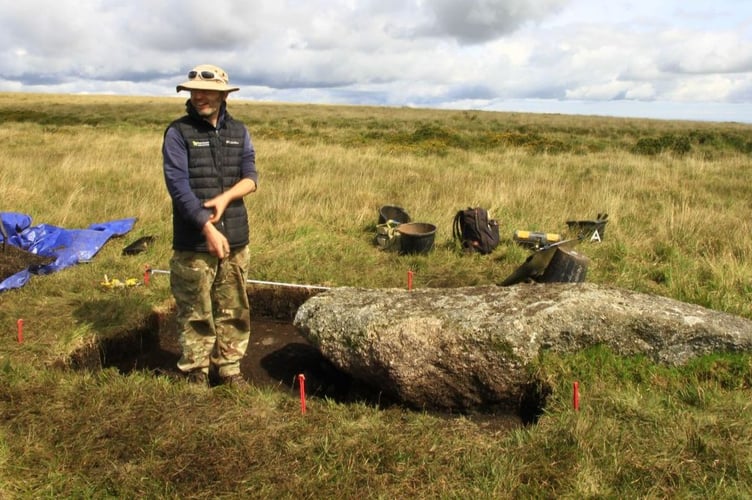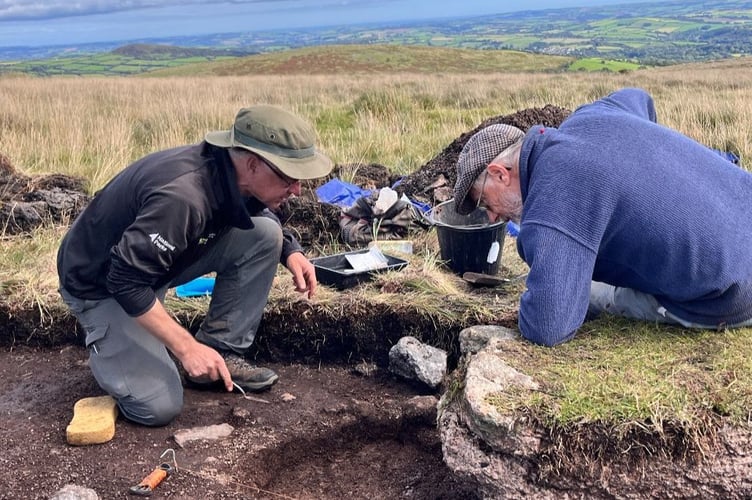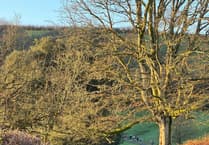A quartz surface – possibly laid deliberately to enhance the setting of a double stone row – has been uncovered during excavations at Piles Hill.
The surprising find was made by Dartmoor National Park Archaeologists, Isca Archaeology and volunteers during a week-long dig aimed at answering some questions posed by the enigmatic monument.
The excavation was part of the Our Upland Commons initiative. Funded by the National Lottery Heritage Fund, Historic England and Dartmoor Preservation Association, it's aimed at increasing understanding of upland commons across Dartmoor and other areas.

The double stone row at Piles Hill spans 850-metres across Ugborough and Harford Moors and aligns east-west, curving slightly upwards like a smile, and is thought to date to the Neolithic/Early Bronze Age.
Monuments like this are thought to have had considerable ritual importance for the people who created and used them thousands of years ago. There are around 40 visible stones; some upright, but most are flat on the ground and hidden by vegetation.
The recumbent nature of the stones has long posed intriguing questions about whether they were laid flat deliberately, had fallen over or if the monument had once been on a different alignment. The excavation aimed to answer some of those questions but as is often proved on Dartmoor, investigations uncovered yet another hidden element of the moorland’s past.
National Park Archaeologist and Excavation Director Andy Crabb said: 'As we’d hoped, excavations uncovered large socket holes underneath the ends of the fallen stones demonstrating that stones once stood upright. This confirmed findings from a geophysical survey last year.

'But we also made a new discovery. In our last trench we uncovered a paved cobble-like surface made of angular rocks consisting predominantly of white quartz. At first, we thought it was the natural geology but further investigations showed otherwise. We think the rocks were brought to the site and laid there deliberately, possibly to enhance the setting of the stone row.
'We met our objectives of increasing our understanding of stone rows on Dartmoor with the bonus of finding something new. It was great working with Isca Archaeology, volunteers, landowners and local commoners on this important project.'
Tamsin Thomas, Our Upland Commons Project Officer for Dartmoor, said: 'Everyone is excited by the findings. If successful, we will upright key stones to draw everyone’s attention to this important scheduled monument so they can be seen as people enjoy these wonderful places.'
Commons like Ugborough and Harford form the heartland of Dartmoor and are one of the reasons for its designation as a National Park in 1951. As well as being landscapes noted for their historic monuments, they support a variety of flora and fauna and are grazed by hardy hill cattle, sheep, and ponies.
Ugborough Moor landowner Dr Leonard Hurrell said: 'We look forward to hearing about any discoveries which came about as a result of this work; we have always been intrigued as to the significance of such a sizeable construction, which must have been a very prominent feature in the ancient landscape.'

Harford Moor landowner John Howell said: 'The archaeological work has confirmed our impression that this was once an outstanding feature, with the double line of large stones prominent over the top of the hill. I am delighted that we have learnt more about this important monument.'
While the dig concluded earlier this month, post-excavation work continues. It's hoped precise dateable evidence and environmental information can be extracted from site samples while funding to set the stones in their original upright position will be explored.
This wouldn't be the first time a type of surface has been found during excavations on Dartmoor or further afield. A paved causeway was found at The Hurlers, a prehistoric complex on the granite uplands of Bodmin Moor, during a dig in the 1930s.




